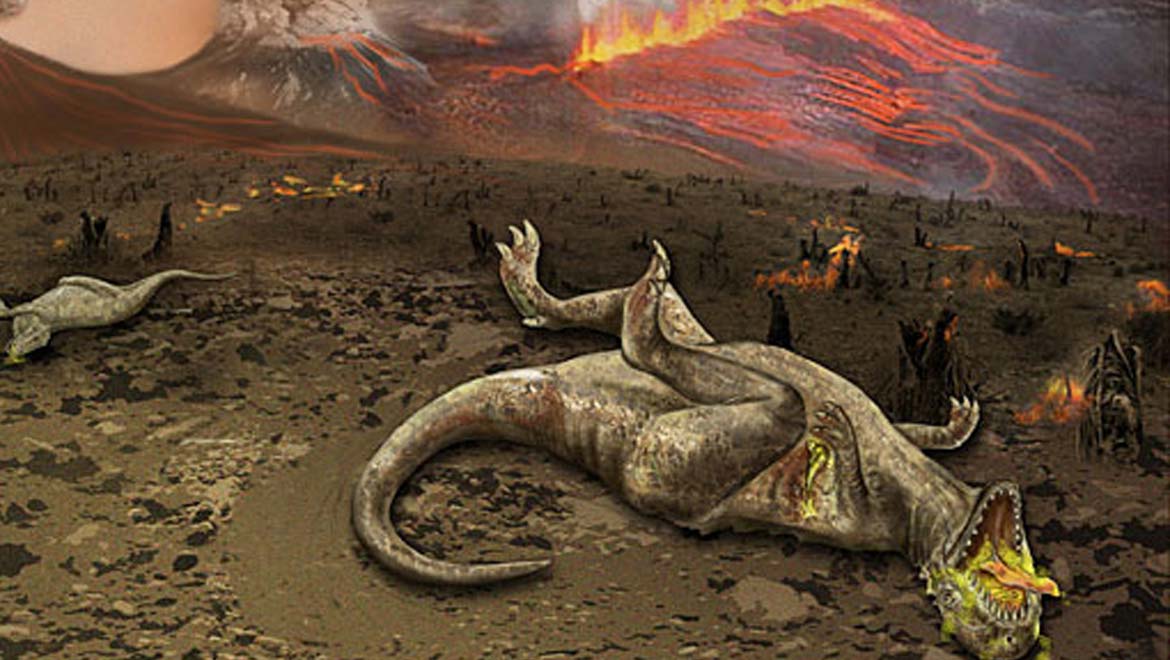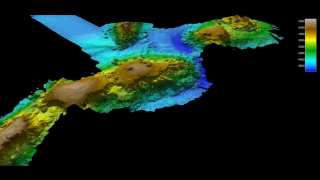It is generally accepted among scientists that flightless dinosaurs were wiped out by a mass extinction event. This has strongly been associated with the end of the Cretaceous (K) era and the start of the Paleogene (Pg). However, geologists and paleontologists have faced difficulties in pinpointing a causative factor for this K-Pg event. One of the most prominent candidates is the Chicxulub meteorite strike.
However, there is another: the Deccan Traps eruption.
The Deccan Traps Eruptions and the Dinosaurs
This event is thought of as a series of colossal, catastrophic volcanic eruptions that may have lasted thousands (if not tens of thousands) of years. Evidence for this has been found at its original site, which is located in what is now the volcanic Deccan Traps region of India. It is thought to have spewed an incredible amount of magma onto the Earth’s surface, while also possibly filling the atmosphere with toxic levels of compounds such as methane, sulfur dioxide, and carbon dioxide.

The Deccan Traps is a region of India that still clearly bears the marks of ancient lava flows. (Source: Wikimedia Commons)
Some scientists conclude that either the Deccan Traps or Chicxulub events could have triggered a mass extinction in their own right. However, it is also possible that they intersected or interacted in a way that ensured that all the large, land-living dinosaurs died as a result of their occurrence. However, it has been difficult to place both events on the Earth’s timeline with complete accuracy, especially in relation to each other.
When did the Deccan Traps Event Happen?
The latest research on the subject of the asteroid that caused the Chicxulub strike – also known as the Chicxulub bolide – puts it at approximately 66 million years ago (or roughly at the end of the K era). However, the timing of the Deccan event has been more difficult to determine.
Two new studies conducted by two separate groups have tackled this ongoing mystery. They each used different methods of radio-dating in order to determine when the series of eruptions began, and their duration, with greater precision, compared to previous projects on the same subject.
One of these set out to do so through the technique of uranium-lead (U-Pb) dating. This method exploits the tendency of radiogenic U to decay in a regular, metronomic fashion until it is converted into isotypes of Pb instead. This occurs when the U atoms are trapped within crystals of zircon, which are present in magma as it is thrown up in the course of a volcanic eruption.
This form of dating was employed by a team from Princeton, the Berkeley Geochronology Center, California, the University of Lausanne, Switzerland and Amravati University, India, and led by Blair Schoene of Princeton.

Zircon – which can be cut by lasers even at the micrometric scale – can be important in geochronological studies. (Source: Wikimedia Commons)
This group extracted zircon from the three larger of the volcanic formations that have persisted at the Deccan site since the 'eruption event.' These samples were analyzed for U-Pb decay, which could indicate when the volcanoes at Deccan Traps were activated and for how long.
The team reported that their findings led them to conclude that there had been four major magma extrusions in total. Each of them lasted about 100,000 years, which implies the potential to significantly alter the atmosphere of the entire planet with gases and magma particles.
According to the group’s new radio-dating findings, these eruptions occurred at least 10,000 years prior to the Chicxulub event. However, the second study on the same subject disputes this conclusion.
This one was conducted by C. J. Sprain and her team, who collaborated across the University of Liverpool, UK, the Berkeley Geochronology, Drexel University, Philadelphia, and the Indian Institute of Technology in Bombay, India. They used a different form of dating: argon-argon (40Ar/39Ar). This method measured the ratio of 40-argon to argon that had decayed slightly (to 39-argon) in the same sample.
This technique was conducted using mineral samples from Deccan Traps. Its analysis resulted in the conclusion that the majority of the lava outflow in the region – approximately 75% of it – occurred after Chicxulub. In fact, the argon dating placed the bolide strike at about 600,000 years prior to the lava’s appearance. Therefore, it appears that the two forms of dating have resulted in wildly conflicting results.
Nevertheless, the U.S. Geological Survey’s Seth Burgess has subsequently assessed these studies, and has judged both to be “more precise than their predecessors and uniquely valuable in their own way.”
Could Either Set of Results Be Right?
Burgess has written a perspective in a February 2019 issue of Science on these two new sets of findings, in which he writes, "Ever better datasets permit ever more detailed interrogation of the rock record, which answers some questions, but also generates new ones."
The geologist may have a valid point: U-Pb dating, while seen by many scientists as highly accurate, has its shortfalls. For example, it works on materials such as zircon only, whereas 40Ar/39Ar dating can be applied to a much wider range of minerals (e.g., sanidine or biotite) found at an eruption site.
Furthermore, U-Pb dating has been found to generate dates that can be as much as 100,000 years later than those of actual eruption dates. In addition, this form of dating has a margin of error of about 40,000 years either way.
On the other hand, argon dating has also resulted in estimations that may have preceded the eruption event in question.
Nevertheless, both studies have resulted in very different pictures of the potential relationship between the Chicxulub and Deccan Traps events:
The Sprain findings suggest that the volcanic activity occurred long after the meteorite hit the earth, thus ensuring the completion of the mass extinction kicked off by the strike.
The Schoene team’s conclusions, on the other hand, suggest that the Deccan eruptions may have been the cataclysm that started the extinction, and that Chicxulub was the ‘icing on the cake,’ as it were.
All in all, we still don’t have an answer for the initial question of what actually caused the K-Pg mass extinction. However, it is now certain that we have much more high-quality data on one potential cause. Its re-examination and validation may result in an even clearer idea of what actually happened all those millions of years ago, one day in the future.
Top Image: An artist’s rendition of the mass extinction in conjunction with the Deccan Traps event. (Source: National Science Foundation, Zina Deretsky/Wikimedia Commons)







No comment